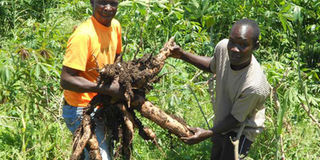Hey, cassava offers sweet mandazi

Charles Ouma (left) and Isaiah Omondi, members of Kamicha Kabondo Group in Kisumu. PHOTO | ELIZABETH OJINA | NATION MEDIA GROUP
What you need to know:
- Pamela says they harvest and sell cassavas from the farmers at intervals to avoid flooding the market. A kilo of the tubers goes for Sh100.On the other hand, cassava cuttings go for Sh600 per 90kg bag.
- They have sold the cuttings to Kenya Red Cross, Ministry of Agriculture and to farmers in Meru, Kakamega, Kericho and Kisumu. To make the flour, cassava tubers are washed thoroughly in clean water to get rid of the soil.
Three kilometres from Ahero, Kisumu County, in Kachola village, sits Isaiah Odongo’s two-acre cassava farm.
I find Odongo, a member of Kamicha Kabondo Development Group, harvesting the hardy crop.
Some days earlier, he had sold two 90kg bags of cassava tubers and a bag of cuttings.
However, that is not all that Odongo got from the crop. Together with other members of the group, they used cassava to make mandazis, chapatis, cakes, cookies crisps, ugali, porridge and chips.
The products help to make the crop that is considered ‘orphaned’ because it is not planted by many accessible to consumers.
“Many people despise cassava but it is a very nutritious crop. Our people know that you can only make ugali from cassava flour and use the leaves as vegetable but the crop is versatile once you know how to add value to it,” says Pamela Okuta, the chairperson of the group. The farmers went into cassava production in 2010 after getting training from an NGO.
“The organisation took us through cultivation, value addition, marketing and to the formation of a savings and credit society,” says Pamela.The 90-member group plants different varieties of the improved cassava. These are MM/99 series, MM/66 series, MH/96 series and Mijera. Each member has their own cassava farm, planting at different intervals, thus, ensuring that they have produce all-year round.
Pamela says they harvest and sell cassavas from the farmers at intervals to avoid flooding the market. A kilo of the tubers goes for Sh100.On the other hand, cassava cuttings go for Sh600 per 90kg bag.
They have sold the cuttings to Kenya Red Cross, Ministry of Agriculture and to farmers in Meru, Kakamega, Kericho and Kisumu. To make the flour, cassava tubers are washed thoroughly in clean water to get rid of the soil.
“We then peel them using a machine, chop into pieces and finally place in a solar drier for two days,” she explains. Some of the solar-dried cassavas are used to make crisps by being deep-fried in oil. “We package the crisps into sachets and sell from Sh10 to Sh50 depending on the size. They have a shelf-life of three months.” Odongo, on the other hand, says the processed flour is packaged into 500g and a kilo packets that go for Sh50 and Sh100 respectively. To make chapatis, mandazi, cakes and cookies, the cassava flour is mixed with wheat flour at the ratio of 3:1. One then uses the standard procedures to cook them.
Similarly, the cassava flour can be used to make ugali and porridge, but this is not added to wheat flour.
A doughnut goes for Sh10 and each chapati for Sh20. Cakes are sold for between Sh250 and Sh500 depending on the size.
“Adding cassava flour to wheat in that ratio cuts the over-reliance on the latter to make various products,” says Pamela. However, diseases such cassava mosaic and cassava brown streak pose a major challenge in the production of the crop. Robert Musyoki, the chief research officer at Simlaw Seeds Company, says cassava mosaic and brown streak are viral diseases that attack the crop leading to major losses.
To curb them, a farmer should get cassava cuttings from reputable suppliers.
like the Kenya Agricultural and Livestock Research Organisation. “When you realise you have planted infected cuttings, you can’t treat the diseases. You must uproot and plant fresh ones.”
Charles Ouma, the group’s treasurer, says they mainly make and sell their value-added products on order to locals in Kisumu, Siaya and Homa Bay, making about Sh20,000 in a month. “We have a group share of Sh1.7 million. After the sale of cassava, members deposit their shares into the group’s bank account, which is later shared annually depending on each member’s input,” says Ouma.




